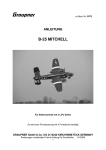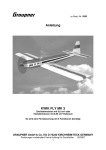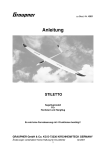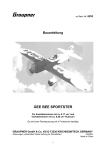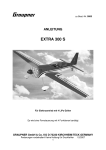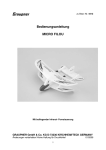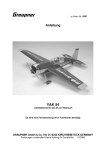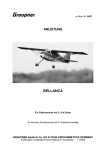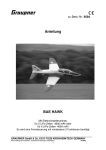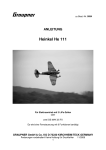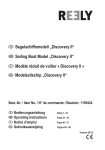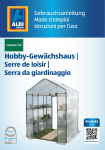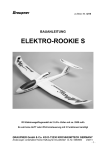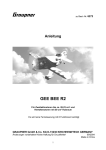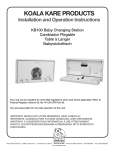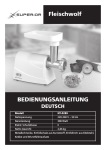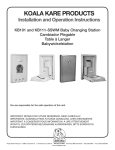Download wilga 2000
Transcript
zu Best.-Nr. 9371 ANLEITUNG WILGA 2000 Für Elektroantrieb mit 3 LiPo-Zellen Es wird eine Fernsteuerung mit 4 Funktionen benötigt GRAUPNER GmbH & Co. KG D-73230 KIRCHHEIM/TECK GERMANY Änderungen vorbehalten! Keine Haftung für Druckfehler 1 04/2007 Technische Daten Spannweite ca. Rumpflänge ohne Spinner ca. Gesamtflächeninhalt ca. Fluggewicht je nach Ausrüstung ca. EWD Schwerpunktbereich gemessen Vorderkante Nasenleiste 1060 mm 845 mm 54,5 dm² 540 g ca. 0,5° ca. 63 mm Vorwort Das GRAUPNER Modell WILGA 2000 S ist ein superleichtes, formschönes Motormodell. Es wurde besonders Wert auf ein geringes Abfluggewicht gelegt, was sich in den Flugleistungen und Flugeigenschaften wiederspiegelt. Die Flugeigenschaften machen die WILGA 2000S zum idealen Modell für den Einstieg in dreiachsgesteuerte Modelle. Einfacher Kunstflug ist möglich. Durch das verwendete Profil besitzt das Modell sehr gutmütige und neutrale Flugeigenschaften. Der Aufbau des Modells ist überwiegend aus Hartschaum gefertigt. Der Tragflügel besitzt einen CFK- Holm. Die Tragflügel sind teilbar, so dass das Modell leicht transportiert werden kann. Für die Fertigstellung sind nur wenige Arbeitsgänge notwendig, wie z.B. das Einkleben des Seitenleitwerks. Das Höhenleitwerk wird mittels zweier Zylinderblechschrauben am Rumpf befestigt. Zum Fliegen des Modells reicht eine RC-Anlage mit 4 Funktionen. Achtung: Dieses Modell ist kein Spielzeug! Sollten Sie mit solch motorisiertem Modell keine Erfahrung haben, wenden Sie sich bitte an erfahrene Modellflieger, die Sie unterstützen können. Es könnte zu Verletzungen kommen, wenn das Modell ohne Vorkenntnisse in Betrieb genommen wird. Denken Sie an die Sicherheit und Ihre Gesundheit. Wichtige Sicherheitshinweise Sie haben einen Bausatz erworben, aus dem – zusammen mit entsprechendem geeignetem Zubehör – ein funktionsfähiges RC-Modell fertiggestellt werden kann. Die Einhaltung der Montage- und Betriebsanleitung im Zusammenhang mit dem Modell sowie die Installation, der Betrieb, die Verwendung und Wartung der mit dem Modell zusammenhängenden Komponenten können von GRAUPNER nicht überwacht werden. Daher übernimmt GRAUPNER keinerlei Haftung für Verluste, Schäden oder Kosten, die sich aus dem fehlerhaften Betrieb, aus fehlerhaftem Verhalten bzw. in irgendeiner Weise mit dem Vorgenannten zusammenhängend ergeben. Soweit vom Gesetzgeber nicht zwingend vorgeschrieben, ist die Verpflichtung der Firma GRAUPNER zur Leistung von Schadensersatz, aus welchem Grund auch immer ausgeschlossen (inkl. Personenschäden, Tod, Beschädigung von Gebäuden sowie auch Schäden durch Umsatz- oder Geschäftsverlust, durch Geschäftsunterbrechung oder andere indirekte oder direkte Folgeschäden), die von dem Einsatz des Modells herrühren. Die Gesamthaftung ist unter allen Umständen und in jedem Fall beschränkt auf den Betrag, den Sie tatsächlich für dieses Modell gezahlt haben. GRAUPNER GmbH & Co. KG D-73230 KIRCHHEIM/TECK GERMANY Änderungen vorbehalten! Keine Haftung für Druckfehler 2 04/2007 Die Inbetriebnahme und der Betrieb des Modells erfolgt einzig und allein auf Gefahr des Betreibers. Nur ein vorsichtiger und überlegter Umgang beim Betrieb schützt vor Personen- und Sachschäden. Nach der neuen Regelung des §103 Abs. 3 LuftVZO müssen alle Flugmodelle, egal ob Slowflyer, Parkflyer, Segelflugzeuge, Flugmodelle mit Antrieben jeglicher Art vor Aufnahme des Flugbetriebs versichert sein. Schließen Sie daher eine spezielle RCModell-Haftplichtversicherung ab. Fragen hierzu werden Ihnen vom Fachhandel gerne beantwortet. Diese Sicherheitshinweise müssen unbedingt aufbewahrt werden und müssen bei einem Weiterverkauf des Modells an den Käufer weitergegeben werden. Herstellererklärung: Sollten sich Mängel an Material oder Verarbeitung an einem von uns in der Bundesrepublik Deutschland vertriebenen, durch einen Verbraucher (§ 13 BGB) erworbenen Gegenstand zeigen, übernehmen wir, die Fa. Graupner GmbH & Co KG, D-73230 Kirchheim/Teck im nachstehenden Umfang die Mängelbeseitigung für den Gegenstand. Rechte aus dieser Herstellererklärung kann der Verbraucher nicht geltend machen, wenn die Beeinträchtigung der Brauchbarkeit des Gegenstandes auf natürlicher Abnutzung, Einsatz unter Wettbewerbsbedingungen, unsachgemäßer Verwendung (einschließlich Einbau) oder Einwirkung von außen beruht. Diese Herstellererklärung lässt die gesetzlichen oder vertraglich eingeräumten Mängelansprüche und –rechte des Verbrauchers aus dem Kaufvertrag gegenüber seinem Verkäufer (Händler) unberührt. Umfang der Garantieleistung Im Garantiefall leisten wir nach unserer Wahl Reparatur oder Ersatz der mangelbehafteten Ware. Weitergehende Ansprüche, insbesondere Ansprüche auf Erstattung von Kosten im Zusammenhang mit dem Mangel (z.B. Ein-/Ausbaukosten) und der Ersatz von Folgeschäden sind – soweit gesetzlich zugelassen – ausgeschlossen. Ansprüche aus gesetzlichen Regelungen, insbesondere nach dem Produkthaftungsgesetz, werden hierdurch nicht berührt. Voraussetzung der Garantieleistung Der Käufer hat den Garantieanspruch schriftlich unter Beifügung des Originals des Kaufbelegs (z.B. Rechnung, Quittung, Lieferschein) und dieser Garantiekarte geltend zu machen. Er hat zudem die defekte Ware auf seine Kosten an die o.g. Adresse einzusenden. Der Käufer soll dabei den Material- oder Verarbeitungsfehler oder die Symptome des Fehlers so konkret benennen, dass eine Überprüfung unserer Garantiepflicht möglich wird. Der Transport des Gegenstandes vom Verbraucher zu uns als auch der Rücktransport erfolgen auf Gefahr des Verbrauchers. GRAUPNER GmbH & Co. KG D-73230 KIRCHHEIM/TECK GERMANY Änderungen vorbehalten! Keine Haftung für Druckfehler 3 04/2007 Gültigkeitsdauer Diese Erklärung ist nur für während der Anspruchsfrist bei uns geltend gemachten Ansprüche gültig. Die Anspruchsfrist beträgt 24 Monate ab Kauf des Gerätes durch den Verbraucher bei einem Händler in der Bundesrepublik Deutschland (Kaufdatum). Werden Mängel nach Ablauf der Anspruchsfrist angezeigt oder die zur Geltendmachung von Mängeln nach dieser Erklärung geforderten Nachweise oder Dokumente erst nach Ablauf der Anspruchsfrist vorgelegt, so stehen dem Käufer keine Rechte oder Ansprüche aus dieser Erklärung zu. Verjährung Soweit wir einen innerhalb der Anspruchsfrist ordnungsgemäß geltend gemachten Anspruch aus dieser Erklärung nicht anerkennen, verjähren sämtliche Ansprüche aus dieser Erklärung in 6 Monaten vom Zeitpunkt der Geltendmachung an, jedoch nicht vor Ende der Anspruchsfrist. Anwendbares Recht Auf diese Erklärung und die sich daraus ergebenden Ansprüche, Rechte und Pflichten findet ausschließlich das materielle deutsche Recht ohne die Normen des Internationalen Privatrechts sowie unter Ausschluss des UN-Kaufrechts Anwendung. Wichtig! Bevor Sie mit dem Bau beginnen! Auch wenn Sie schon viele RC-Modelle gebaut haben, lesen Sie diese Anleitung genauestens durch und kontrollieren Sie die Teile dieses Bausatzes auf Vollständigkeit. Es wurde viel Mühe darauf verwandt, den Aufwand möglichst einfach zu halten, ohne die Sicherheit zu beeinträchtigen. Das weitgehend vorgefertigte Modell benötigt nur noch wenig Bauzeit. Aber die verbleibenden Arbeiten sind wichtig und müssen sorgfältig ausgeführt werden. Von deren einwandfreier Ausführung hängt es ab, ob das Modell letztlich die vorgesehene Festigkeit und Flugeigenschaften haben wird; deshalb langsam und präzise arbeiten! Hinweis zur Benutzung von WILGA 2000 Vor dem Versuch der ersten Inbetriebnahme muss die gesamte Betriebs- und Montageanleitung sorgfältig gelesen werden. Sie alleine sind verantwortlich für den sicheren Betrieb Ihres RC-Flugmodells. Bei Jugendlichen unter 14 Jahren muss der Bau und Betrieb von einem Erwachsenen, der mit den Gegebenheiten und möglichen Gefahren eines RC-Flugmodells vertraut ist, verantwortlich überwacht werden. Diese Bedienungsanleitung muss sorgfältig aufbewahrt und im Falle einer Weitergabe dem nachfolgenden Benutzer unbedingt mit ausgehändigt werden. Fragen, die die Sicherheit beim Betrieb des RC-Flugmodells betreffen, werden Ihnen vom Fachhandel gerne beantwortet. Fernsteuer-Flugmodelle sind sehr anspruchsvolle und gefährliche Gegenstände und erfordern vom Betreiber einen hohen Sachverstand, Können und Verantwortungsbewusstsein. GRAUPNER GmbH & Co. KG D-73230 KIRCHHEIM/TECK GERMANY Änderungen vorbehalten! Keine Haftung für Druckfehler 4 04/2007 Rechtlich gesehen, ist ein Flugmodell ein Luftfahrzeug und unterliegt entsprechenden Gesetzen, die unbedingt eingehalten werden müssen. Die Broschüre »Modellflugrecht, Paragrafen und mehr«, Best.-Nr. 8034.01, stellt eine Zusammenfassung dieser Gesetze dar; sie kann auch beim Fachhandel eingesehen werden. Ferner müssen postalische Auflagen, die die Fernlenkanlage betreffen, beachtet werden. Entsprechende Hinweise finden Sie in der Bedienungsanleitung Ihrer Fernsteueranlage. Es dürfen nur die im Bausatz enthaltenen Teile, sowie die ausdrücklich von uns empfohlenen Original-Graupner Zubehör- und Ersatzteile verwendet werden. Wird auch nur eine Komponente der Antriebseinheit geändert, ist ein sicherer Betrieb nicht mehr gewährleistet und es erlischt jeglicher etwaiger Garantieanspruch. Verwenden Sie immer nur passende, verpolungssichere Steckverbindungen. Alle stromführenden Leitungen, Steckverbindungen sowie die Antriebsbatterie, bei Selbstkonfektionierung, kurzschlusssicher isolieren. Kombinieren Sie niemals unterschiedliche Kontakte, z. B. Blech- und Goldkontakte, da hier keine sichere Funktion gewährleistet ist. Bei Verwendung von Schaltern bzw. Reglern mit Empfängerstromversorgung nur Steckverbindungen mit Graupner-Gold-Kontakten verwenden. Kurzschlüsse und Falschpolungen vermeiden. Durch die hohe Energie der LiPo-Batterien besteht Explosions- und Brandgefahr. Ein RC-Flugmodell kann nur funktionsfähig sein und den Erwartungen entsprechen, wenn es im Sinne der Bauanleitung sorgfältigst gebaut wurde. Nur ein vorsichtiger und überlegter Umgang beim Betrieb schützt vor Personen- und Sachschäden. Niemand würde sich in ein Flugzeug setzen und - ohne vorausgegangene Schulung - versuchen damit zu fliegen. Auch Modellfliegen will gelernt sein. Der Hersteller hat jedoch keine Möglichkeit, den Bau und den Betrieb eines RC- Flugmodells zu beeinflussen. Deshalb wird hiermit auf die Gefahren nachdrücklich hingewiesen und jede Haftung dafür abgelehnt. Bitte wenden Sie sich dazu an erfahrene Modellflieger, an Vereine oder Modellflugschulen. Ferner sei auf den Fachhandel und die einschlägige Fachpresse verwiesen. Am besten als Club-Mitglied auf zugelassenem Modellflugplatz fliegen. Sie alleine sind verantwortlich für den sicheren Betrieb Ihres RC- Flugmodells. Fragen, die die Sicherheit beim Betrieb des RC-Flugmodells betreffen, werden Ihnen vom Fachhandel gerne beantwortet. Klebstoffe und Lacke enthalten Lösungsmittel, die unter Umständen gesundheitsschädlich sein können. Beachten Sie daher unbedingt auch die entsprechenden Hinweise und Warnungen der Hersteller. Der Betreiber muss im Besitz seiner vollen körperlichen und geistigen Fähigkeiten sein. Wie beim Autofahren, ist der Betrieb des Flugmodells unter GRAUPNER GmbH & Co. KG D-73230 KIRCHHEIM/TECK GERMANY Änderungen vorbehalten! Keine Haftung für Druckfehler 5 04/2007 Alkohol oder Drogeneinwirkung nicht erlaubt. Informieren Sie alle Passanten und Zuschauer vor der Inbetriebnahme über alle möglichen Gefahren, die von Ihrem Modell ausgehen und ermahnen diese, sich in ausreichendem Schutzabstand, wenigstens 5 m hinter der Luftschraubenebene, aufzuhalten. Stets mit dem notwendigen Sicherheitsabstand zu Personen oder Gegenständen fliegen; nie Personen in niedriger Höhe überfliegen oder auf sie zufliegen! Modellflug darf nur bei Außentemperaturen von -5º C bis +35º C betrieben werden. Extremere Temperaturen können zu Veränderungen von z. B. Akkukapazität, Werkstoffeigenschaften und mangelhaften Klebeverbindungen führen. Jeder Modellflieger hat sich so zu verhalten, dass die öffentliche Sicherheit und Ordnung, insbesondere andere Personen und Sachen, sowie die Ordnung des Modellflugbetriebs nicht gefährdet oder gestört wird. Das Flugmodell niemals in der Nähe von Hochspannungsleitungen, Industriegelände, in Wohngebieten, öffentlichen Straßen, Plätzen, Schulhöfen, Parks und Spielplätzen usw. fliegen lassen. Warnungen müssen unbedingt beachtet werden. Sie beziehen sich auf Dinge und Vorgänge, die bei einer Nichtbeachtung zu schweren - in Extremfällen tödlichen Verletzungen oder bleibenden Schäden führen können. Luftschrauben und generell alle sich drehenden Teile, die durch einen Motor angetrieben werden, stellen eine ständige Verletzungsgefahr dar. Sie dürfen mit keinem Körperteil berührt werden! Eine schnell drehende Luftschraube kann z. B. einen Finger abschlagen! Sich niemals in oder vor der Drehebene von Luftschrauben aufhalten! Es könnte sich doch einmal ein Teil davon lösen und mit hoher Geschwindigkeit und viel Energie wegfliegen und Sie oder Dritte treffen. Darauf achten, dass kein sonstiger Gegenstand mit einer laufenden Luftschraube in Berührung kommt! Die Blockierung der Luftschraube, durch irgendwelche Teile, muss ausgeschlossen sein. Vorsicht bei losen Kleidungsstücken wie Schals, weiten Hemden usw.: sie werden vom Propellerstrahl angesaugt und können in den Luftschraubenkreis gelangen. Überprüfen Sie vor jeder Inbetriebnahme das Modell und alle an ihm gekoppelten Teile (z. B. Luftschrauben, Getriebe, RC-Teile usw.) auf festen Sitz und mögliche Beschädigungen. Das Modell darf erst nach Beseitigung aller Mängel in Betrieb genommen werden. GRAUPNER GmbH & Co. KG D-73230 KIRCHHEIM/TECK GERMANY Änderungen vorbehalten! Keine Haftung für Druckfehler 6 04/2007 Auf gute Standfestigkeit achten, wenn Sie das Modell in der Hand halten. Passendes Schuhwerk, z. B. Sportschuhe tragen. Vergewissern Sie sich, dass die verwendete Frequenz frei ist. Erst dann einschalten! Funkstörungen, verursacht durch Unbekannte, können stets ohne Vorwarnung auftreten! Das Modell ist dann steuerlos und unberechenbar! Fernlenkanlage nicht unbeaufsichtigt lassen, um ein Betätigen durch Dritte zu verhindern. Elektromotor nur einschalten, wenn nichts im Drehbereich der Luftschraube ist. Nicht versuchen, die laufende Luftschraube anzuhalten. Elektromotor mit Luftschraube nur im fest eingebauten Zustand laufen lassen. Die Fluglage des Modells muss während des gesamten Fluges immer eindeutig erkennbar sein, um immer ein sicheres Steuern und Ausweichen zu gewährleisten. Machen sich während des Fluges Funktionsbeeinträchtigungen/Störungen bemerkbar, muss aus Sicherheitsgründen sofort die Landung eingeleitet werden. Sie haben anderen Luftfahrzeugen stets auszuweichen. Start- und Landeflächen müssen frei von Personen und sonstigen Hindernissen sein. Immer auf vollgeladene Akkus achten, da sonst keine einwandfreie Funktion der RC-Anlage gewährleistet ist. Niemals heiß gewordene, defekte oder beschädigte Batterien verwenden. Es sind stets die Gebrauchsvorschriften des Batterieherstellers zu beachten. Vor jedem Flug eine Überprüfung der kompletten RC-Anlage, sowie des Flugmodells auf volle Funktionstüchtigkeit und Reichweite durchführen. Dabei ist zu beachten, dass bei der Inbetriebnahme die Motorsteuerfunktion am Sender immer zuerst in AUS-Stellung gebracht wird. Danach Sender und dann erst Empfangsanlage einschalten, um ein unkontrolliertes Anlaufen des Elektromotors zu vermeiden. Gleichfalls gilt immer zuerst Empfangsanlage ausschalten, danach erst den Sender. Überprüfen Sie, dass die Ruder sich entsprechend der Steuerknüppelbetätigung bewegen. Beim Bewegen des Querruder-Steuerknüppels nach rechts muss das rechte Querruder nach oben und das linke Querruder nach unten ausschlagen. Beim Bewegen des Höhen-/Tiefenruder-Knüppels nach hinten, zum Bauch, muss das Ruder nach oben ausschlagen. Beim Fliegen keine abrupten Steuerknüppelbewegungen durchführen. Mit diesen Hinweisen soll auf die vielfältigen Gefahren hingewiesen werden, die durch unsachgemäße und verantwortungslose Handhabung entstehen können. Richtig und gewissenhaft betrieben ist Modellflug eine kreative, lehrreiche und erholsame Freizeitgestaltung. Hinweise zum Bau und Flugbetrieb von WILGA 2000 Bevor mit dem Bau begonnen wird: GRAUPNER GmbH & Co. KG D-73230 KIRCHHEIM/TECK GERMANY Änderungen vorbehalten! Keine Haftung für Druckfehler 7 04/2007 Achten Sie beim Kauf einer Funkfernsteuerung darauf, dass die Sende- und Empfangsgeräte auch für Flugmodelle geeignet und bei der Deutschen Bundespost-Telekom zugelassen sind und eine FTZ-Serienprüfnummer besitzen. In den Frequenzbereichen für Funkfernsteuerungen werden auch andere Funkanlagen und Hochfrequenzgeräte betrieben. Deshalb kann kein Schutz vor Störungen durch solche Geräte gewährt werden. Der Betrieb einer Funkfernsteuerung für Flugmodelle auf den freigegebenen Kanälen im 35 MHz-Band ist gebührenfrei. Weitere Informationen zu diesem Thema bekommen Sie bei Ihrer örtlichen TelekomNiederlassung oder bei Ihrem Modellbau-Fachhändler. Anleitung und Warnhinweise zur Benutzung von LiPo – Akkus Den allgemeinen Hinweis für die Benutzung von LiPo- Akkus entnehmen Sie bitte, die, dem Akkupack beiliegenden Beipackzettel. Allgemeine Warnhinweise Die Akkus dürfen nicht in Feuer gelangen oder eingeäschert werden. Ebenso dürfen die Zellen nicht in Flüssigkeiten wie Wasser, Meerwasser oder Getränke eingetaucht werden. Jeder Kontakt mit Flüssigkeit gleich welcher Art ist zu vermeiden. Einzelne Zellen und Akkus sind kein Spielzeug und dürfen deshalb nicht in die Hände von Kindern gelangen. Akkus/Zellen außerhalb der Reichweite von Kindern aufbewahren. Akkus dürfen nicht in die Nähe von Babys oder Kleinkinder gelangen. Sollten Akkus verschluckt worden sein, so ist sofort ein Arzt oder Notarzt aufzusuchen. Akkus dürfen nicht in eine Mikrowelle oder unter Druck geraten. Rauch und Feuer und noch vieles mehr können die Folgen sein. Zerlegen Sie niemals einen LiPo-Akku. Das Zerlegen eines Akkus kann interne Kurzschlüsse verursachen. Gasentwicklung, Feuer und Explosionen oder andere Probleme können die Folge sein. Die in den LiPo-Akkus enthaltenen Elektrolyte und Elektrolytdämpfe sind gesundheitsschädlich. Vermeiden Sie in jedem Fall direkten Kontakt mit Elektrolyte. Bei Kontakt von Elektrolyte mit Haut, Augen oder anderen Körperteilen muss ein sofortiges Aus- oder Abspülen mit ausreichend frischem Wasser vorgenommen werden, anschließend muss ein Arzt konsultiert werden. Im Gerät eingebaute Akkus immer aus den Geräten entnehmen, wenn das Gerät gerade nicht verwendet wird. Geräte nach dem Gebrauch immer ausschalten um Tiefentladungen zu vermeiden. Akkus immer rechtzeitig aufladen. Akkus auf einer nicht brennbaren, hitzebeständigen und nicht leitenden Unterlage lagern! Tiefentladene LiPo Akkus sind defekt und dürfen nicht mehr verwendet werden! • WICHTIG: Der im Modell eingebaute Akku darf nicht im Hausmüll entsorgt werden. Der Akku muss in Altbatterierücknahmebehältern entsorgt werden. GRAUPNER GmbH & Co. KG D-73230 KIRCHHEIM/TECK GERMANY Änderungen vorbehalten! Keine Haftung für Druckfehler 8 04/2007 • WICHTIG: Das Modell und der Sender dürfen nicht im Hausmüll entsorgt werden und müssen auf einem Wertstoffhof als Elektroschrott abgegeben werden. Erkundigen Sie sich hierzu bei Ihrer Gemeinde. Während der Bauphase RC-Teile sowie Rudergestänge werden während des Zusammenbaus nach den entsprechenden Baustufen eingebaut. Ein späterer Einbau ist gar nicht oder nur sehr schwierig möglich. Die Bauanleitung ist größtenteils in der Reihenfolge des Zusammenbaus gehalten. Die nachfolgenden Hinweise sollen noch zusätzlich einige Erläuterungen geben. Abweichungen von der aufgeführten Reihenfolge beim Bau des Modells sind nach eigenem Ermessen vorzunehmen. Achten Sie darauf, dass Balsamesser, Stecknadeln, dünne Drahtenden usw. spitz bzw. scharf sind und somit leicht zu Verletzungen führen können. Achten Sie darauf, dass Kinder keinen Zugang zu Werkzeugen, Klebstoffen oder Lacken haben. Sorgen Sie bei Klebstoffen mit Lösungsmitteln für einen gut belüfteten Raum. Geben Sie Klebstoff- und Farbreste bei Sondermüllsammelstellen ab. Eine großzügig bemessene freie Arbeitsfläche ist bei allen Bastelarbeiten von besonderem Vorteil. Lassen Sie sich schwierige Arbeitsgänge von erfahrenen Modellbauern zeigen, wenn Sie noch wenig Erfahrung im Modellbau haben. Verhaltensregeln Betreiben Sie Ihr Modell niemals auf öffentlichen Straßen, Wegen und Plätzen, Gebäuden oder in der Nähe von Hochspannungsleitungen. Lassen Sie die WILGA 2000 niemals in Naturschutz- oder Landschaftsschutzgebieten fliegen. Nehmen Sie Rücksicht auf die dort lebenden Tiere und Pflanzen. Bäume und Sträucher dienen als Kinderstube, Nist- und Lebensraum von Vögeln. Gefährden Sie niemals Tiere, Zuschauer oder andere Piloten. Funkfernsteuerung für WILGA 2000 Als Funkfernsteuerung schlagen wir folgende minimale Ausrüstung vor: 1 Computer System X-408 im 35 MHz-Band, z. B. Best.-Nr. 4713 oder 4713.B 1 Verlängerungskabel Best.-Nr. 3935.11 Die entsprechenden Ladegeräte dazu siehe GRAUPNER Hauptkatalog FS. GRAUPNER GmbH & Co. KG D-73230 KIRCHHEIM/TECK GERMANY Änderungen vorbehalten! Keine Haftung für Druckfehler 9 04/2007 Elektroantrieb und Zubehör 1 LiPo-Akku-Pack Best.-Nr. 7631.3 Erforderliches Material und Werkzeug Schraubendreher Kreuzschlitz z.B. Best.-Nr. 810 Flachzange, Stahllineal, Schere z.B. Best.-Nr. 26, Balsamesser z.B. Best.-Nr. 980, Sprühlack z.B. Best.-Nr. 928.27, Klebstoffe UHU por, Best.-Nr. 959 UHU-Schraubensicher, Best.-Nr. 952 Lacke Zum Lackieren des Modells darf nur Lack verwendet werden, der hartschaumverträglich ist, z.B. GRAUPNER Styropor-Sprühlack Best.-Nr. 928. oder UNIVERSAL-Lack Best.-Nr. 921. Farbton nach eigener Vorstellung oder die Abbildung auf dem Kartondeckel als Vorlage verwenden. Die Abbildung auf dem Kartondeckel entspricht einer Originallackierung. Der Zusammenbau der WILGA 2000 Beginnen Sie erst mit dem Zusammenbau, wenn Sie sich mit den Bauteilen und einzelnen Baustadien vertraut gemacht haben. Sollte ein Bauteil Grund zur Beanstandung geben, so ist diese vor Baubeginn Ihrem Fachhändler mitzuteilen. Der Rumpf Wie auf dem Foto zu sehen, den Fahrwerksbügel in die Aufnahmenut stecken und mittels der Verriegelung gegen Herausrutschen sichern. Vor dem Einkleben des Seiten- und dem Aufschrauben des Höhenleitwerks werden die Befestigungsschrauben der montierten Ruderhörner evtl. soweit in die Gegenplatte eingeschraubt, dass die Ruderhörner fest mit den Rudern verbunden sind. Damit sich Seiten- und Höhenruder leicht bewegen lassen, werden an einem Stahllineal entlang, die transparent durchscheinenden Zwischenräume an den Drehachsen der Ruder mit einem scharfen Balsamesser herausgetrennt. GRAUPNER GmbH & Co. KG D-73230 KIRCHHEIM/TECK GERMANY Änderungen vorbehalten! Keine Haftung für Druckfehler 10 04/2007 Jetzt wird das Seitenleitwerk bis zum Anschlag, vorne und unten in die Aufnahmenut gesteckt. Mit der, der Packung beiliegendem Klebstoff, die Seitenflossen gegen Herausrutschen sichern. Mit den zwei beiliegenden Zylinderblechschrauben Ø1,7x8 mm das Höhenleitwerk auf den Rumpf schrauben, bis es unverrückbar befestigt ist. GRAUPNER GmbH & Co. KG D-73230 KIRCHHEIM/TECK GERMANY Änderungen vorbehalten! Keine Haftung für Druckfehler 11 04/2007 Den Spornfahrwerksbügel in den Aufnahmeschlitz, im Rumpfende, stecken und durch ein paar Tropfen Klebstoff gegen Herausrutschen sichern. Zur Montage der Luftschraube, wie auf dem Foto zu sehen, eine M3 Mutter soweit auf die Motorwelle drehen, dass ca. 8 mm Gewinde nach vorne frei bleibt. Mutter mit UHU-Schraubensicher gegen Lösen sichern. Nach dem Trocknen des Sicherungslackes die Luftschraube aufstecken, so dass die Mutter in die Sechskantaussparung auf der Rückseite der Luftschraube kommt. Die Rückseite der Luftschraube ist die Seite ohne Größenkennzeichnung (8x6). Jetzt die Luftschraube an einem Blatt festhalten und von vorne auf die Motorwelle, die weiße Kunststoffsicherung aufdrehen und mittels einer Flachzange festziehen. GRAUPNER GmbH & Co. KG D-73230 KIRCHHEIM/TECK GERMANY Änderungen vorbehalten! Keine Haftung für Druckfehler 12 04/2007 Jetzt wird der Spinner mittels einer Zylinderblechschraube Ø2,3x7,5 mm an der Kunststoffsicherung befestigt. Bei Mittelstellung der Servos für Seiten- und Höhenruder die Länge der beiden Gestänge justieren, so dass sich die Ruder in Mittelstellung befinden. Wenn dies sichergestellt ist werden die Gabelköpfe in die äußersten Bohrungen der Ruderhörner eingeclipst. Jetzt die Anschlusskabel der beiden Servos und des Drehzahlreglers sowie das Verlängerungskabel für das Querruderservo, in die entsprechende Buchse des Empfängers stecken. Der Empfänger kann mittels Doppelklebeband an der Rumpfinnenseite befestigt werden. GRAUPNER GmbH & Co. KG D-73230 KIRCHHEIM/TECK GERMANY Änderungen vorbehalten! Keine Haftung für Druckfehler 13 04/2007 Die Antenne wird aus dem Rumpfboden zum Rumpfende heraus geführt und mittels Klebstreifen befestigt. Damit mit der WILGA 2000 auch vom Wasser oder im Winter von Schnee gestartet und gelandet werden kann, liegen der Packung Schwimmer bei. Zur Montage der Schwimmer am Rumpf müssen die beiden Befestigungsbügel, wie auf dem Foto zu sehen, an den Schwimmer befestigt werden. Die Befestigungsbügel werden durch Aufschieben der Sicherungsringe, auf die Enden der Bügel, gesichert. GRAUPNER GmbH & Co. KG D-73230 KIRCHHEIM/TECK GERMANY Änderungen vorbehalten! Keine Haftung für Druckfehler 14 04/2007 Der Tragflügel Die beiden Querruder sind nur provisorisch an den Tragflügelhälften befestigt. Die Klebstreifen entfernen, um die Vorderkante der beiden Querruder, wie auf dem Foto zu sehen, zu verschleifen. Die Querruderbefestigung der beiden Querruder an den Tragflächen erfolgt mittels Klebestreifen, welche vom Dekorbogen ausgeschnitten werden müssen. Der lange Streifen wird so auf die Oberseite der Querruder geklebt, dass er zur Hälfte an der Vorderkante der Ruder übersteht. Mittels dem überstehenden Klebestreifen die Querruder an die Tragflächen kleben. Hierbei ist darauf zu achten, dass beim Ankleben das Ruder auf Vollausschlag nach unten gehalten wird. In dieser Stellung den Klebestreifen auf der Tragflügeloberseite andrücken. GRAUPNER GmbH & Co. KG D-73230 KIRCHHEIM/TECK GERMANY Änderungen vorbehalten! Keine Haftung für Druckfehler 15 04/2007 Jetzt den Tragflügel umdrehen und das Querruder umschlagen, so dass es mit der Oberseite auf der Oberseite der Tragfläche aufliegt. Nun werden, je Tragfläche, drei kurze Klebstreifen auf die Unterseite geklebt. Dabei ist darauf zu achten, dass die Klebeseite der Klebestreifen zusammengeklebt werden. Je ein Streifen an den Enden und einen in der Mitte des Ruders ankleben. Jetzt die beiden Tragflügelhälften mittels dem Kunststoffverbinder zusammenstecken. In den Servoanlenkhebel die beiden Anlenkgestänge einhängen. Das kurze Gestänge wird rechts, das Lange links in die äußersten Bohrungen des Servohebels, mit der Doppelabkröpfung eingehängt. Hierzu muss der Servohebel abgeschraubt und nach dem Einhängen der beiden Gestänge wieder befestigt werden. Die beiden Gabelköpfe müssen so justiert werden, dass bei Servo- und Rudermittelstellung die Gabelköpfe in die äußerste Bohrung der Ruderhörner eingehängt werden können. Beim Montieren der Tragfläche auf dem Rumpf kontrollieren, dass die beiden Querrudergestänge sich frei bewegen können, evtl. muss die Aussparung im Rumpf etwas nachgeschnitten werden. GRAUPNER GmbH & Co. KG D-73230 KIRCHHEIM/TECK GERMANY Änderungen vorbehalten! Keine Haftung für Druckfehler 16 04/2007 Zusammenbau der WILGA 2000 Die beiden Tragflügelhälften mittels dem Kunststoffverbinder zusammenstecken. Das Querruderservoanschlusskabel an das Verlängerungskabel anschließen. Die Zapfen der Kunststoffbefestigungen an der Nasenleiste des Tragflügels in die Bohrungen des Kunststoffteils im Rumpf stecken. Tragflügel mittels der beiden Metallschrauben, M4x25 mm, auf dem Rumpf befestigen. Schrauben nur so fest anziehen, bis der Tragflügel unverrückbar auf dem Rumpf befestigt ist. Auswiegen der WILGA 2000 Der Schwerpunkt liegt ca.63 mm hinter der Nasenleiste des Tragflügels, genau in der Mitte des CFK-Holms. Dieser wird erreicht, wenn als Antriebsakku ein LiPo-Akku Best.-Nr. 7631.3 verwendet wird. Vor dem Erstflug müssen sämtliche Ruder, bei Sendertrimmung in Mitte, genau auf Mittelstellung (Nullstellung) gebracht werden, Gabelköpfe entsprechend justieren. Ruderausschläge für Normalflug Querruder nach oben und unten 8 mm Höhenruder nach oben und unten 15 mm Seitenruder nach rechts und links 15 mm Fliegen mit WILGA 2000 Der Antrieb ist so ausgelegt, dass mit dem Modell, aufgebaut mit Schwimmern, problemlos vom Wasser gestartet werden kann. Zum Fliegen reicht aber dann ca. 1/3 Motorleistung aus, wodurch eine sehr realistische Fluggeschwindigkeit erreicht wird. Das Modell kann nur über Seiten- und Höhenruder gesteuert werden. Hierbei ist die Reaktion auf Seitenruder etwas sanfter, als wenn mit Querruder gesteuert wird. Es muss nach jedem Flug der Motor abgekühlt werden. Wichtig: Bei der Montage der Gestänge grundsätzlich sorgfältig darauf achten, dass diese leicht laufen, ihren vollen steuerbaren Weg - einschließlich Trimmung - ausführen können und keinesfalls mechanisch begrenzt werden. Beim Bewegen des Steuerknüppels nach rechts, muss das Seitenruder nach rechts ausschlagen (links/links). Beim Bewegen des Höhen-/Tiefenruder-Knüppels nach hinten, sprich zum Bauch, muss das Höhenruder nach oben ausschlagen (vorne = nach unten). Beim Bewegen des Querruder-Steuerknüppels nach rechts, muss das rechte Querruder nach oben, das Linke nach unten ausschlagen. Beim Bewegen des Gasknüppels nach vorne, muss der Motor in Vollgasstellung laufen. Nun bleibt nur noch viel Spaß und Freude beim Fliegen mit Ihrer WILA 2000 zu wünschen. Ihr Team ! GRAUPNER GmbH & Co. KG D-73230 KIRCHHEIM/TECK GERMANY Änderungen vorbehalten! Keine Haftung für Druckfehler 17 04/2007 Hinweise zum Umweltschutz Das Symbol auf dem Produkt, der Gebrauchsanleitung oder der Verpackung weist darauf hin, dass dieses Produkt bzw. elektronische Teile davon am Ende seiner Lebensdauer nicht über den normalen Haushaltsabfall entsorgt werden dürfen. Es muss an einem Sammelpunkt für das Recycling von elektrischen und elektronischen Geräten abgegeben werden. Die Werkstoffe sind gemäß ihrer Kennzeichnung wiederverwertbar. Mit der Wiederverwendung, der stofflichen Verwertung oder anderen Formen der Verwertung von Altgeräten leisten Sie einen wichtigen Beitrag zum Umweltschutz. Batterien und Akkus müssen aus dem Gerät entfernt werden und bei einer entsprechenden Sammelstelle getrennt entsorgt werden. Bei RC-Modellen müssen Elektronikteile, wie z.B. Servos, Empfänger oder Fahrtenregler aus dem Produkt ausgebaut und getrennt bei einer entsprechenden Sammelstelle als Elektro-Schrott entsorgt werden. Bitte erkundigen Sie sich bei der Gemeindeverwaltung die zuständige Entsorgungsstelle. GRAUPNER GmbH & Co. KG D-73230 KIRCHHEIM/TECK GERMANY Änderungen vorbehalten! Keine Haftung für Druckfehler 18 04/2007 Réf. N°9371 WILGA 2000 Instructions de montage Pour propulsion électrique alimentée par 3 éléments LiPo Un ensemble R/C à 4 voies est nécessaire Caractéristiques techniques Envergure, env. Longueur du fuselage sans le cône Surface totale Poids en ordre de vol, selon équipement Différence de calage d’incidence Centre de gravité mesuré derrière le bord d’attaque de l’aile 1060mm 845mm 54,5 dm² 540 g. env. 0,5° env. 63mm Avant-propos Le WILGA 2000 GRAUPNER est un modèle d’avion super léger aux formes élégantes. Une attention particulière a été apportée pour l’obtention d’un faible poids au décollage qui se reflète sur les caractéristiques et les performances de vol. Ces caractéristiques de vol font du WILGA 2000 le modèle idéal pour débuter dans le pilotage sur trois axes. La voltige simple est possible. Grâce au profil d’aile utilisé, le modèle est doté de caractéristiques de vol stables et neutres. La structure du modèle est réalisée en grande partie en mousse der plastique dure. L’aile comprend un longeron en fibre de carbone. L’aile est démontable en deux parties et facilite le transport du modèle. Peu de travaux sont nécessaires pour la finition du modèle, comme par ex. le collage de la dérive. Le stabilisateur est fixé au moyen de deux vis parker à tête cylindrique. Un ensemble R/C à 4 voies suffit pour le pilotage de ce modèle. Attention : Ce modèle n’est pas un jouet ! Si vous n’avez encore aucune expérience avec ce genre de modèle, adressez-vous à un modéliste expérimenté qui pourra vous assister. Des blessures peuvent être causées lorsque le modèle est utilisé sans connaissances préalables. Pensez à la sécurité et à votre santé ! Conseils de sécurité importants Vous avez fait l'acquisition d'une boite de construction avec les accessoires correspondants qui vont vous permettre la réalisation d'un modèle radiocommandé. Le respect des instructions de montage et d'utilisation relatives au modèle ainsi que l'installation, l'utilisation et l'entretien des éléments de son équipement ne peuvent pas être surveillés par la Firme GRAUPNER. C'est pourquoi nous déclinons toute responsabilité concernent les pertes, les dommages ou les coûts résultants d'une mauvaise utilisation ou d'un fonctionnement défectueux. Tant qu'elle n'y a pas été GRAUPNER GmbH & Co. KG D-73230 KIRCHHEIM/TECK GERMANY Änderungen vorbehalten! Keine Haftung für Druckfehler 19 04/2007 contrainte par le législateur, la responsabilité de la Firme GRAUPNER n'est aucunement engagée pour les dédommagements (incluant les dégâts personnels, les cas de décès, la détérioration de bâtiments ainsi que le remboursement des pertes commerciales dues à une interruption d'activité ou à la suite d'autres conséquences directes ou indirectes) provenant de l'utilisation du modèle. L'ensemble de sa responsabilité est en toutes circonstances et dans chaque cas strictement limitée au montant que vous avez réellement payé pour ce modèle. L'utilisation du modèle se fait uniquement aux risques et périls de son utilisateur. Seule une utilisation prudente et responsable évitera de causer des dégâts personnels et matériels. Les modèles motorisés de tous genres doivent être assurés avant leur utilisation. Contractez pour cela une assurance spéciale pour les modèles radiocommandés. Demandez à votre revendeur qui vous renseignera volontiers. Ces conseils de sécurité devront être soigneusement conservés et remis à l’acheteur en cas de revente du modèle. Déclaration du fabricant Graupner GmbH & Co. KG Contenu de la déclaration du fabricant Lorsqu’un article que nous distribuons dans la République Fédérale d’Allemagne acquis par un consommateur (§ 13 BGB) présente un défaut de matière ou de fabrication, nous la Firme Graupner GmbH & Co. KG, Kirchheim Teck, prenons en charge la suppression du défaut de l’article dans les conditions ci après. Le consommateur ne peut pas valider le droit de déclaration du fabricant lorsque le défaut de l’article provient d’une usure naturelle, d’une utilisation dans des conditions de compétition, d’une mauvaise utilisation (incluant le montage) ou d’influences extérieures. Cette déclaration du fabricant laisse inchangés le droit et les réclamations légales ou contractuelles du consommateur provenant du contrat d’achat vis à vis de son vendeur (le détaillant). Etendue de la garantie En cas de garantie, nous faisons le choix de réparer ou d’échanger la marchandise défectueuse. Toutes autres réclamations, particulièrement sur le remboursement des coûts engendrés par le défaut (par ex. coûts de montage/démontage) et la compensation de dommages provoqués en conséquence – même autorisés légalement – sont exclues. Les réclamations provenant des réglementations légales, en particulier selon la loi de la responsabilité du fabricant, ne seront pas ici abordées. Droit à la garantie L’acheteur peut faire valoir le droit à la garantie en joignant le bon d’achat original (par exemple facture, ticket de caisse, bon de livraison) et cette carte de garantie. Il doit en outre retourner la marchandise défectueuse à ses frais à l’adresse suivante : GRAUPNER Service France 86 rue St Antoine F-57601 Forbach-Oeting L’acheteur doit indiquer concrètement le défaut de matière ou de fabrication ou le symptôme du défaut pour permettre l’examen de notre devoir de garantie. GRAUPNER GmbH & Co. KG D-73230 KIRCHHEIM/TECK GERMANY Änderungen vorbehalten! Keine Haftung für Druckfehler 20 04/2007 Le transport du produit de chez le consommateur à chez nous, tout comme le transport du retour se font aux risques et périls du consommateur. Durée de validité Cette déclaration est seulement valable pour la période accordée aux réclamations provenant de cette déclaration. Le délai de réclamation est de 24 mois à partir de la date de l’achat du produit par le consommateur chez un commerçant en République Fédérale d’Allemagne (date d’achat). Si les défauts sont signalés après le délai de réclamation autorisé ou bien si les preuves ou les documents pour faire valoir les défauts selon cette déclaration sont présentés après le délai de réclamation, l’acheteur n’a aucun droit de réclamation ou requêtes en provenance de cette déclaration. Prescription Tant que nous ne reconnaissons pas la réclamation à faire valoir dans la période de réclamation accordée dans le cadre de cette déclaration, l’ensemble des réclamations de cette déclaration sont prescrites pendant 6 mois à partir de leur validation, cependant pas avant la fin du délai de réclamation. Droit applicable Dans le cadre de cette déclaration et des réclamations, des droits et devoirs, qui en résultent, seul et uniquement le Droit matériel allemand s’applique, sans possibilité d’utiliser les normes du Droit privé international et celles de la Commission du Droit de vente des Nations Unies. Important! A lire avant de commencer la construction! Même si vous avez déjà construit de nombreux modèles R/C, veuillez lire attentivement ces instructions et vérifier si les pièces contenues dans cette boite de construction sont complètes. Beaucoup d'efforts ont été faits pour rendre la construction la plus simple possible, sans pour autant nuire à la sécurité. Ce modèle largement préfabriqué ne nécessite encore que peu de temps pour sa finition. Mais les travaux restants sont importants et devront être effectués avec soin. De leur parfaite exécution dépendront la solidité finale prévue pour le modèle et ses performances de vol; c'est pourquoi il conviendra de travailler avec patience et précision! Conseils pour l’utilisation du WILGA 2000 Avant de tenter la première mise en service, les instructions de montage et d’utilisation devront être attentivement lus. Vous être seul responsable de la sécurité d’utilisation de votre modèle R/C. Les jeunes gens en dessous de 14 ans devront effectuer les assemblages et utiliser le modèle sous la surveillance d’un adulte familiarisé avec les particularités et les dangers possibles que peut présenter un modèle R/C. Ces instructions d’utilisation devront être conservées avec soin afin de pouvoir les remettre à l’utilisateur suivant en cas de vente du modèle. Demandez à votre revendeur les mesures de sécurité à prendre avec l’utilisation d’un modèle R/C, il vous renseignera volontiers. Les modèles d'avions R/C sont des appareils pouvant être dangereux et qui exigent de leur utilisateur une grande compétence et la conscience de sa responsabilité. GRAUPNER GmbH & Co. KG D-73230 KIRCHHEIM/TECK GERMANY Änderungen vorbehalten! Keine Haftung für Druckfehler 21 04/2007 Un modèle réduit volant est comparable à un véritable aéronef pour lequel toutes les dispositions légales doivent être prises; la possession d'une assurance est obligatoire. Il conviendra d'utiliser exclusivement les éléments fournis dans la boite de construction ainsi que les accessoires d'origine Graupner et les pièces détachées conseillées. Si un seul composant de la propulsion est remplacé, une parfaite sécurité de fonctionnement de peut plus être assurée et peut entraîner la perte du bénéfice de la garantie. Utilisez toujours des connecteurs adaptés entre-eux avec sécurité contre les inversions de polarité. Tous les conducteurs de courant, les connexions ainsi que les batteries de confection personnelle devront être isolés contre les court circuits. Ne combinez jamais des connecteurs différents, par ex. des contacts en tôle avec des contacts dorés, car ici aucune sécurité de fonction ne pourra être garantie. Avec l’utilisation des commutateurs et des régulateurs assurant l’alimentation de la réception, utilisez uniquement des connecteurs Graupner à contacts dorés. Evitez les court circuits et les inversions de polarité. Par la forte énergie emmagasinée par les batteries LiPo, il existe un danger d’explosion et d’incendie. Un modèle volant R/C ne peut évoluer correctement que s'il a été construit et réglé conformément aux instructions de montage et seule une utilisation prudente et responsable évitera de provoquer des dommages matériels ou corporels. Le pilotage sûr d’un modèle réduit n’est possible qu’après un entraînement ou un écolage appropriés. Le fabricant n'a cependant aucune possibilité d'influencer la construction et l'utilisation d'un modèle de sa production. C'est pourquoi nous attirons ici l'attention sur les dangers représentés en dégageant toute responsabilité. Faites-vous assister par un modéliste expérimenté, ou inscrivez-vous dans une association ou dans une école de pilotage. Consultez en outre votre revendeur et la Presse spécialisée. Le mieux est de faire partie d'un club d'aéromodélisme pour pouvoir voler sur un terrain autorisé. Les colles et les peintures contiennent des solvants qui dans certaines conditions peuvent être nocifs pour la santé. Pour cette raison, observez impérativement le mode d'emploi et les avertissements indiqués par le fabricant correspondant. L'utilisateur doit être en pleine possession de ses facultés physiques et mentales. Comme pour la conduite des automobiles, le pilotage des modèles volants sous l'effet de l'alcool ou de la drogue n'est pas autorisé. Avant de faire voler votre modèle, informez tous les passants et les spectateurs sur les dangers qu'il peut présenter et demandez-leur de se tenir à une distance de sécurité d’au moins 5 m derrière le champ de rotation de l’hélice. GRAUPNER GmbH & Co. KG D-73230 KIRCHHEIM/TECK GERMANY Änderungen vorbehalten! Keine Haftung für Druckfehler 22 04/2007 Tenez-vous à une distance de sécurité suffisante de personnes ou d'objets; ne survolez jamais de personnes à basse altitude et ne volez jamais dans leur direction. Un modèle volant R/C ne doit voler que par des températures extérieures comprises entre – 5° à + 35°C. Des températures extrêmes peuvent conduire par ex. à une modification de la capacité des accus, des propriétés des matériaux et de la résistance des collages. Chaque modéliste doit se comporter de façon à ce que l'ordre et la sécurité publiques, vis-à-vis des autres personnes et des biens, ainsi que l'activité des autres modélistes ne soient pas mis en danger, ni perturbés. Ne faites jamais voler votre modèle à proximité des lignes à haute tension, dans les zones industrielles, les agglomérations, sur les voies publiques, les places, dans les cours d'école, les parcs et les aires de jeux, etc… Les avertissements donnés devront être impérativement respectés. Leur non-observation peut conduire à de sérieux dommages et dans les cas extrêmes à des blessures graves. Les hélices et en général toutes les pièces mécaniques entraînées par un moteur présentent un danger de blessures permanent et ne doivent être touchées par aucune partie du corps! Une hélice tournant à haut régime peut par ex. couper un doigt! Ne vous tenez jamais dans le champ de rotation d'une hélice! Une pièce peut se détacher et être éjectée à haute vitesse avec une forte inertie et vous toucher, ou une tierce personne. Veillez également à ce qu'aucun objet quelconque vienne en contact avec l'hélice en rotation. Le blocage de l’hélice par un objet quelconque doit absolument être exclu. Veillez également aux vêtements flottants tels qu'écharpe ou cravate, etc…qui peuvent être aspirés et s'enrouler sur l'hélice. Avant chaque utilisation, vérifiez le modèle et toutes les pièces qui y sont rattachées (par ex. hélice, réducteur, éléments R/C, etc…) pour détecter une possible détérioration. Ce n'est qu'après avoir remédié à tous les défauts éventuels que le modèle pourra être mis en vol. Assurez-vous que la fréquence que vous utilisez est libre avant de mettre votre émetteur en contact! Une perturbation peut toujours se produire pour une cause inconnue, sans prévenir! Le modèle devient alors incontrôlable et livré à lui-même! Ne laissez pas votre émetteur sans surveillance pour éviter une manipulation par un tiers. Ne mettez le moteur électrique en contact que lorsque rien ne se trouve dans le champ de rotation de l’hélice. Faites tourner le moteur électrique avec l’hélice montée uniquement lorsqu’il est solidement fixé dans le modèle. La position du modèle doit être nettement identifiable durant tout le vol pour garantir un pilotage sûr. Si vous remarquez l'influence d'une perturbation durant le vol, préparez-vous immédiatement à atterrir pour des raisons de sécurité. Durant le départ et le processus d'atterrissage, le terrain doit être libre de toute personne et d'obstacle. Veillez toujours au bon état de charge des accus, car autrement le parfait fonctionnement de l'ensemble R/C ne peut être garanti. N’utilisez jamais de batteries échauffées, défectueuses ou détériorées. Observez les prescriptions d’utilisation indiquées par le fabricant des batteries GRAUPNER GmbH & Co. KG D-73230 KIRCHHEIM/TECK GERMANY Änderungen vorbehalten! Keine Haftung für Druckfehler 23 04/2007 Avant chaque vol, effectuez une vérification complète du bon fonctionnement de l’installation R/C ainsi que du modèle et faites un essai de portée. Pour faire un essai de fonctionnement du moteur, assurez-vous d’abord que l’organe de commande soit sur la position COUPE sur l’émetteur. Mettez ensuite d’abord l’émetteur en contact, ensuite la réception pour éviter un démarrage involontaire du moteur. Procédez inversement pour couper le contact ; d’abord celui de la réception, ensuite celui de l’émetteur. Vérifiez si les gouvernes se déplacent dans le sens correspondant des manches de commande. Ces conseils mettent en évidence la diversité des dangers pouvant résulter d'une manipulation incorrecte et irresponsable. Leur observation permettra de pratiquer en toute sécurité ce loisir créatif et éducatif que représente l'aéromodélisme. Conseils pour la construction et l’utilisation du WILGA 2000 Instructions et avertissements pour l’utilisation des accus LiPo Pour l’utilisation des accus LiPo, relevez les conseils généraux donnés sur l’étiquette jointe aux packs d’accus. Avertissements généraux Les accus ne devront pas être jetés au feu ni être incinérés. Les éléments ne devront pas non plus être trempés dans des liquides, comme l’eau, l’eau de mer, etc... Tout contact avec des liquides du même genre doit être évité. Les éléments seuls et les packs d’accus ne sont pas des jouets et pour cette raison, ils devront être conservés hors de la portée des enfants. Ne jamais démonter un accu LiPo sous peine de provoquer un court-circuit interne. Un dégagement de gaz, une mise à feu, une explosion ou un autre problème peuvent s’ensuivre. L’électrolyse et ses vapeurs contenues dans les accus LiPo sont nocives pour la santé. Eviter tout contact direct avec l’électrolyse. En cas de contact avec la peau, les yeux ou toute autre partie du corps, se rincer abondamment à l’eau fraîche et consulter ensuite un médecin. Les accus incorporés dans un appareil devront être retirés de celui-ci lorsqu’il n’est pas utilisé. Couper toujours l’appareil après son utilisation pour éviter une décharge profonde. Charger toujours régulièrement les accus. Charger les accus sur une base non inflammable, résistante à la chaleur et non conductrice ! Les accus LiPo profondément déchargés sont défectueux et ne devront plus être utilisés ! IMPORTANT : Les accus et les appareils électroniques usagés ne devront pas être jetés dans une poubelle domestique, mais dans un container spécialement réservé à leur récupération pour le recyclage. Renseignezvous auprès de l’administration de votre commune sur la présence de ces containers. Durant les assemblages Les éléments R/C ainsi que les transmissions de gouverne devront être installés au cours des stades de montage correspondants. Un montage ultérieur ne serait que très difficile, voire impossible ! Les instructions de montage Elle sont- rédigées en grande partie dans l’ordre des assemblages à effectuer. Les conseils qui vont suivre donnent encore quelques explications supplémentaires. Quelques déviations dans l’ordre indiqué pour les assemblages pourront être décidées sur initiative personnelle. Notez qu’un couteau à balsa, les épingles, les fils métalliques fins, etc… sont coupants et pointus et peuvent facilement provoquer des blessures. Veillez à ce que les jeunes enfants n’aient pas accès aux outils, aux colles ou aux peintures. Utilisez les colles contenant un solvant dans un local bien aéré. Jetez les restes de colle et de peinture dans un container spécial réservé à cet GRAUPNER GmbH & Co. KG D-73230 KIRCHHEIM/TECK GERMANY Änderungen vorbehalten! Keine Haftung für Druckfehler 24 04/2007 usage. Une surface de travail largement dimensionnée est toujours avantageuse pour tous les travaux de bricolage. Si vous n’avez encore que peu d’expérience en modélisme, faites-vous montrer les travaux difficiles à exécuter par un modéliste expérimenté. Règles du comportement Ne faites jamais voler votre modèle sur les voies publiques, les routes et les places, ou à proximité des habitations et des lignes à haute tension. Ne faites pas voler le WILGA 2000 dans une nature protégée. Prenez en considération les lieux où vivent les animaux et les plantes. Les arbres et les buissons servent de nids et d’habitats aux oiseaux. Ne mettez jamais en danger les animaux, les spectateurs ou les autres pilotes. Equipement R/C pour le WILGA 2000 L’équipement minimum suivant est conseillé : 1 Système à micro-ordinateur X-408 en 41 MHz, 1 Cordon de rallonge Réf. N°4729.41 Réf. N°3935.11 Pour le chargeur correspondant, voir dans le catalogue général FS. Propulsion électrique et accessoires 1 Pack d’accus LiPo Réf. N°7631.3 Matériel et outils nécessaires Un tournevis cruciforme, par ex. Réf. N°810, des pinces plates, un réglet métallique, des ciseaux par ex. N°26, un couteau à balsa par ex. Réf. N°980, une bombe de peinture par ex. Réf. N°928.27. Colles UHU por, Réf. N°959 Freine filert UHU, Réf. N°952 Peintures Pour peindre le modèle, il conviendra d’utiliser uniquement des peintures compatibles avec la mousse de plastique dure, comme par ex. les peintures en bombe pour Styropor GRAUPNER Réf. N°928, ou UNIVERSAL-Lack, Réf. N°921. Utiliser des teintes aux préférences personnelles ou prendre l’illustration sur le cartonnage comme modèle ; cette illustration correspond à une peinture originale. Les assemblages du WILGA 2000 Commencez les assemblages lorsque vous serez familiarisé avec les pièces et les différents stades de montage. Si l’une des pièces fait l’objet d’une réclamation, consultez votre revendeur également avant de commencer les assemblages. GRAUPNER GmbH & Co. KG D-73230 KIRCHHEIM/TECK GERMANY Änderungen vorbehalten! Keine Haftung für Druckfehler 25 04/2007 Le fuselage Mettre en place les jambes du train d’atterrissage dans le logement sous le fuselage et les fixer avec le verrouillage, comme montré sur la photo. Avant le collage de la dérive et la fixation du stabilisateur monter les guignols sur les gouvernes avec les vis et les contre plaques. Afin que les gouvernes de direction et de profondeur puissent se mouvoir librement, séparer l’espace transparent sur leur axe de pivotement avec un couteau à balsa à lame pointue guidée par un réglet métallique. Introduire maintenant la dérive jusqu’en butée à l’avant et à l’arrière dans la rainure sur le dessus du fuselage. Coller le plan fixe de la dérive dans la rainure avec la colle fournie dans l’emballage. Fixer le stabilisateur sur le fuselage avec les deux vis parker à tête cylindrique de Ø1,7x8 mm fournies en les serrant juste suffisamment pour qu’il soit bien immobilisé. Introduire la fourche de la roulette de queue dans la fente à l’extrémité arrière du fuselage et la fixer avec quelques gouttes de colle. Pour la fixation de l’hélice, visser un écrou M3 sur l’arbre du moteur de façon à ce qu’une longueur de filetage d’env. 8mm reste libre vers l’avant. Bloquer l’écrou contre tout risque de desserrage avec du freine filet. Après le séchage du freine filet, mettre en place l’hélice de façon à ce que l’encastrement six pans sur sa face arrière s’encastre sur l’écrou. La face arrière de l’hélice est celle qui ne porte pas l’indication de sa taille (8x6). Tenir maintenant l’hélice par une pale et visser la pièce de sécurité en plastique blanc sur l’arbre du moteur avec des pinces plates. Fixer maintenant le cône d’hélice avec une vis parker à tête cylindrique de Ø2,3x7,5 mm sur la pièce de sécurité en plastique. Avec les servos de direction et de profondeur au neutre, régler la longueur des tringleries de façon à ce que les gouvernes se trouvent aussi en position neutre. Lorsque ceci est assuré, les chapes seront connectées sur le trou extérieur des guignols de gouverne. Connecter maintenant le cordon de raccordement des deux servos et celui du régulateur de vitesse sur les sorties de voie correspondantes du récepteur. Le récepteur pourra être fixé sur le flanc à l’intérieur du fuselage avec de la bande adhésive double face. Faire sortir le fil d’antenne par le fond du fuselage vers son extrémité arrière et le fixer avec du ruban adhésif. Afin que le WILGA 2000 puisse aussi décoller et atterrir sur l’eau ou sur de la neige en hiver, des flotteurs sont fournis dans l’emballage. Pour le montage des flotteurs sur le fuselage, les deux étriers de fixation seront montés sur les flotteurs en introduisant leurs extrémités dans les attaches, comme représenté sur les photos suivantes. L’aile GRAUPNER GmbH & Co. KG D-73230 KIRCHHEIM/TECK GERMANY Änderungen vorbehalten! Keine Haftung für Druckfehler 26 04/2007 Les volets d’ailerons sont seulement montés provisoirement sur les panneaux d’aile. Retirer les bandes adhésives pour poncer le bord avant des deux volets, comme montré sur la photo. Le montage des deux volets d’ailerons sur l’aile se fera avec des bandes adhésives qui devront être découpées sur la planche de décoration. Les bandes longues seront collées sur le dessus des volets de façon à ce que la moitié de leur largeur dépasse le bord avant des volets. En collant les bandes, veiller à ce que les volets soient maintenus totalement braqués vers le bas. Dans cette position, bien presser les bandes adhésives sur le dessus de l’aile. Retourner maintenant l’aile et basculer complètement les volets d’ailerons de façon à ce qu’ils reposent sur le dessus de l’aile. Coller trois courtes bandes adhésives sur le dessous de chaque panneau d’aile. Veiller à ce que la face adhésive des bandes soit collées avec celle opposée. Coller une bande à chaque extrémité des volets et une au milieu. Assembler maintenant les deux panneaux d’aile avec la clé en plastique. Connecter les deux tringleries sur le palonnier du servo. La tringlerie courte sera connectée à droite et la tringlerie longue à gauche dans les trous extérieurs du palonnier du servo par leur contre coudage. Pour cela, le palonnier devra être démonté, puis remonté ensuite sur le servo après la connexion des tringleries. Les deux chapes devront être réglées de façon à ce que qu’avec le servo et les volets d’ailerons en position neutre, elles puissent être connectées sur le palonnier du servo. Lors du montage de l’aile sur le fuselage, contrôler si les deux tringleries d’ailerons peuvent se mouvoir librement, les ouvertures dans le fuselage devront éventuellement être un peu rectifiées. Assemblage du WILGA 2000 Assembler les deux panneaux d’aile au moyen de la clé en plastique. Connecter le cordon de rallonge sur celui du servo d’ailerons. Introduire les chevilles de fixation en plastique sur le bord d’attaque de l’aile dans les perçages de la pièce en plastique dans le fuselage. Fixer l’aile sur le fuselage au moyen des deux vis métalliques M4x25mm. Serrer les vis juste suffisamment pour que l’aile soit bien immobilisée sur le fuselage. Centrage du WILGA 2000 Le centre de gravité est situé à env. 63mm derrière le bord d’attaque de l’aile, exactement au milieu du longeron en fibre de carbone. Le centrage correct obtenu lorsqu’un accu de propulsion LiPo Réf. N°7631.3 sera utilisé. Avant le premier vol, toutes les gouvernes devront être réglées exactement en position neutre avec les leviers de trim sur l’émetteur ; régler les chapes en correspondance. Débattements des gouvernes pour le vol normal : Ailerons 8mm vers le haut et vers le bas Profondeur 15mm vers le haut et vers le bas Direction 15mm vers la droite et vers la gauche GRAUPNER GmbH & Co. KG D-73230 KIRCHHEIM/TECK GERMANY Änderungen vorbehalten! Keine Haftung für Druckfehler 27 04/2007 Le vol avec le WILGA 2000 La propulsion est prévue de façon à ce que le modèle équipé des flotteurs puisse décoller de l’eau sans problème. Mais ensuite, une puissance moteur d’env. 1/3 suffit pour obtenir une vitesse de vol réaliste. Le modèle pourra être piloté uniquement à la direction et à la profondeur. La réaction à la direction est un peu plus souple qu’avec la commande des ailerons. Il faudra laisser le moteur se refroidir après chaque vol. Important : Lors du montage des tringleries, veillez à ce qu’elles puissent se mouvoir librement sur toute la course du servo, incluant le trim, sans être limitées mécaniquement. En déplaçant le manche de commande de direction vers la droite, la gouverne de direction doit se braquer vers la droite (et vers la gauche, à gauche). En tirant le manche de commande de profondeur vers l’arrière (à soi), la gouverne de profondeur soit se soulever (et en la poussant vers l’avant, s’abaisser). En déplaçant le manche de commande des ailerons vers la droite, le volet droit doit se soulever et le gauche s’abaisser. En poussant le manche de commande des gaz en avant, le moteur doit tourner à pleine puissance et être coupé en le tirant vers l’arrière. Il nous reste à vous souhaiter beaucoup de plaisir avec les vols de votre modèle WILGA 2000 ! Votre équipe Graupner ! Indications quant à la protection de l’environnement Ce produit à la fin de sa durée de vie ne doit pas être mis à la poubelle, mais être remis à une collecte pour le recycle ment d'appareils électriques et électroniques. Le symbole inscrit sur le produit, dans la notice d'instructions et sur son emballage l'indique. Les matériaux selon leurs reconnaissances sont réutilisables. Avec le recyclage de matériaux et autres formes d'appareils, vous contribuez à la protection de l'environnement. Les batteries et accus doivent être retirés de l'appareil et doivent être remis à un dépôt homologué pour ce type de produits. Pour les modèles radiocommandés, les pièces électroniques, comme par exemple les servos, récepteur ou variateur de vitesse, doivent être démontés et retirés du produit et être remis à une collecte spécialisée pour produits électroniques. Veuillez s.v.p. demander auprès de votre mairie l'adresse exacte du point de récupération le plus proche de chez vous. GRAUPNER GmbH & Co. KG D-73230 KIRCHHEIM/TECK GERMANY Änderungen vorbehalten! Keine Haftung für Druckfehler 28 04/2007 Order No. 9371 INSTRUCTIONS WILGA 2000 For electric power and three Li-Po cells This model requires a four-function radio control system Specification Wingspan approx. Fuselage length excl. spinner approx. Total surface area approx. All-up weight according to fittings approx. Longitudinal dihedral CG position, measured from wing root leading edge 1060 mm 845 mm 54.5 dm² 540 g approx. 0.5° approx. 63 mm Introduction The GRAUPNER WILGA 2000 is a good-looking ultra-lightweight aerobatic trainer. At the development stage we placed great emphasis on low all-up weight, and this is reflected in the aeroplane’s excellent flying characteristics and performance. The handling of the WILGA 2000 makes it the ideal first “full-house” model aircraft, as it is capable of simple aerobatics. The selected wing section endows the model with very good-natured, neutral flying characteristics. The aircraft is built primarily of high-density foam, while the wing is fitted with a carbon fibre spar. The two-part wing makes the model easy to transport. Completing the machine only involves a few procedures, such as installing the fin. The tailplane is attached to the fuselage using two pan-head self-tapping screws. A four-function RC system is quite sufficient to fly this model. Caution: this model is not a toy! If you are a beginner to this type of powered model, please ask an experienced model flyer for help and support. If you attempt to operate the model without knowing what you are doing, you could easily injure yourself or somebody else. Please keep your safety and well-being in mind at all times. Important Safety Notes GRAUPNER GmbH & Co. KG D-73230 KIRCHHEIM/TECK GERMANY Änderungen vorbehalten! Keine Haftung für Druckfehler 29 04/2007 You have acquired a kit which can be assembled into a fully working RC model when fitted out with suitable accessories. However, we as manufacturers have no control over the way you build and operate your RC model aircraft, nor how you install, operate and maintain the associated components, and for this reason we are obliged to deny all liability for loss, damage or costs which are incurred due to the incorrect use of our products or due to incompetent behaviour on the part of the user, or which are connected with such operation in any way. Unless otherwise prescribed by binding law, the obligation of the GRAUPNER company to pay compensation, regardless of the legal argument employed, is excluded. This includes personal injury, death, damage to buildings, damages due to loss of business or turnover, interruption of business or other direct or indirect consequent damage whose root cause was the operation of the model. The total liability in all cases and under all circumstances is limited to the amount of money which you actually paid for the model. This model is built and flown at the sole and express responsibility of the operator. The only way to avoid injury to persons and damage to property is to handle and operate the model with the greatest care and consideration at all times. The new regulation of §103 Paragraph 3 of the LuftVZO (German Aviation Approvals Office) states that all model aircraft - whether slow-flyer, park-flyer, glider, or model aircraft propelled by any form of power plant - must be insured before the model is operated. If you are not sure about this, please ask at your local model shop where the staff will be glad to advise you. These safety notes must be kept in a safe place. If you ever dispose of the model, be sure to pass them on to the new owner. Manufacturer’s declaration: If material defects or manufacturing faults should arise in a product distributed by us in the Federal Republic of Germany and purchased by a consumer (§ 13 BGB), we, Graupner GmbH & Co. KG, D-73230 Kirchheim/Teck, Germany, acknowledge the obligation to correct those defects within the limitations described below. The consumer is not entitled to exploit this manufacturer’s declaration if the failure in the usability of the product is due to natural wear, use under competition conditions, incompetent or improper use (including incorrect installation) or external influences. This manufacturer’s declaration does not affect the consumer’s legal or contractual rights regarding defects arising from the purchase contract between the consumer and the vendor (dealer). Extent of the guarantee If a claim is made under guarantee, we undertake at our discretion to repair or replace the defective goods. We will not consider supplementary claims, especially for reimbursement of costs relating to the defect (e.g. installation / removal costs) and compensation for consequent damages unless they are allowed by statute. This does not affect claims based on legal regulations, especially according to product liability law. Guarantee requirements GRAUPNER GmbH & Co. KG D-73230 KIRCHHEIM/TECK GERMANY Änderungen vorbehalten! Keine Haftung für Druckfehler 30 04/2007 The purchaser is required to make the guarantee claim in writing, and must enclose original proof of purchase (e.g. invoice, receipt, delivery note) and this guarantee card. He must send the defective goods to us at his own cost, using the address stated above. The purchaser should state the material defect or manufacturing fault, or the symptoms of the fault, in as accurate a manner as possible, so that we can check if our guarantee obligation is applicable. The goods are transported from the consumer to us and from us to the consumer at the risk of the consumer. Duration of validity This declaration only applies to claims made to us during the claim period as stated in this declaration. The claim period is 24 months from the date of purchase of the product by the consumer from a dealer in the Federal Republic of Germany (date of purchase). If a defect arises after the end of the claim period, or if the evidence or documents required according to this declaration in order to make the claim valid are not presented until after this period, then the consumer forfeits any rights or claims from this declaration. Limitation by lapse of time If we do not acknowledge the validity of a claim based on this declaration within the claim period, all claims based on this declaration are barred by the statute of limitations after six months from the time of implementation; however, this cannot occur before the end of the claim period. Applicable law This declaration, and the claims, rights and obligations arising from it, are based exclusively on the pertinent German Law, without the norms of international private law, and excluding UN retail law. Important: before you start construction Even if you have already built a large number of RC models please read right through these instructions and check that all the kit components are present. We have taken great trouble to keep construction as simple as possible, without making any compromises in the area of safety. This model is highly pre-fabricated and can be built in a very short time. However, the work which you have to carry out is important and must be done carefully. The model will only be strong and fly well if you complete your tasks competently. Notes on operating the WILGA 2000 It is essential to read right through the building and operating instructions before you start assembling the model. You alone are responsible for the safe operation of your radio-controlled model. Young persons under fourteen years should only be permitted to operate this model under the instruction and supervision of an adult who is aware of the hazards involved in this activity. Please keep these operating instructions in a safe place. If you ever dispose of the model, be sure to pass them on to the new owner. If you have any questions regarding the safe operation of your RC model aeroplane, please GRAUPNER GmbH & Co. KG D-73230 KIRCHHEIM/TECK GERMANY Änderungen vorbehalten! Keine Haftung für Druckfehler 31 04/2007 turn to your local model shop in the first instance, as the staff will be pleased to help you. Radio-controlled model aircraft are extremely demanding and potentially dangerous objects, and require a high level of expertise, skill and responsibility from the operator. In legal terms our models are classed as aircraft, and as such are subject to legal regulations and restrictions which must be observed at all times. Our brochure “Modellflugrecht, Paragrafen und mehr” (Model Aviation Law, Legal Requirements and more) is available under Order No. 8034.01, and contains a summary of all these rules. Your local model shop should have a copy which you can read. There are also Post Office regulations concerning your radio control system, and these must be observed. Refer to your RC system instructions for more details. Be sure to use only those parts included in the kit, together with other genuine Graupner accessories and replacement parts as recommended expressly by us. Even if you change a single component you can no longer be sure that the system will work reliably, and such changes also invalidate your guarantee. Use only matching polarised electrical connectors. The flight battery, all cables and connectors must be insulated carefully to prevent short-circuits, especially if you make them up yourself. Never combine connectors with contacts of different materials, e.g. tin-plated and gold-plated, as the connections will not be reliable in the long-term. If you are using a motor switch or speed controller with integral receiver power supply (BEC system), be sure to use Graupner gold-contact connectors. Avoid short-circuits and reversed polarity. The high energy density of Li-Po batteries involves a risk of fire and even explosion. A radio-controlled model aircraft can only work properly and fulfil your expectations if it is built very carefully and in accordance with the building instructions. If you wish to avoid injuring people and damaging property it is essential to be careful and painstaking at all stages of building and operating your model. Nobody would climb into a full-size aircraft and try to fly it without undergoing training beforehand, and model flying is also a skill which needs to be learned. As manufacturers we are not in a position to influence the way you build and operate your RC model aircraft, and for this reason we deny all liability. All we can do is expressly point out the hazards involved in this activity. We suggest that you ask an experienced model flyer for help, or join a model club or flight training school. Your local model shop and the specialist magazines are excellent sources of information. If at all possible, it is always best to join a club and fly at the approved model flying site. You alone are responsible for the safe operation of your radio-controlled model. If you have any questions regarding the safe operation of your RC GRAUPNER GmbH & Co. KG D-73230 KIRCHHEIM/TECK GERMANY Änderungen vorbehalten! Keine Haftung für Druckfehler 32 04/2007 model aeroplane, please turn to your local model shop in the first instance, as the staff will be pleased to help you. Adhesives and paints contain solvents which may be hazardous to health under certain circumstances. Read and observe the notes and warnings supplied by the manufacturer of these materials. The operator of the model must be in full possession of his or her bodily and mental faculties. As with car driving, operating a model aircraft under the influence of alcohol or drugs is not permissible under any circumstances. If there are passers-by or spectators at your flying site, make sure that they are aware of the dangers inherent in your activity before you start the motor, and insist that they keep a safe distance away (at least 5 m behind the rotational plane of the propeller). Always keep a safe distance away from people and objects when flying; never fly low over people’s heads, and never fly directly towards them. Radio-controlled models should only be flown in “normal” weather conditions, i.e. a temperature range of -5° to +35° C. More extreme temperatures can lead to changes in battery capacity and material characteristics, weakened glued joints and other unwanted effects. All model flyers should behave in a way that minimises the danger to people and property. Never act in any manner which will disturb other flyers and jeopardise safe, orderly flying at the site. Never operate your model aircraft close to high-tension overhead cables, industrial sites, residential areas, public roads, squares, school playgrounds, public parks or sports grounds etc. Don’t ignore our warnings. They refer to materials and situations which, if ignored, can result in fatal injury or permanent damage. Propellers and other rotating parts which are powered by a motor constitute a permanent hazard and represent a real risk of injury. Don’t touch them with any part of your body. For example, a propeller spinning at high speed can easily cut your finger badly. Keep well clear of the rotational plane of the propeller. You never know when some part may come loose and fly off at high speed, hitting you or anybody else in the vicinity. Never touch the revolving propeller with any object. Ensure that it is impossible for any object to stall or block the propeller. Take care with loose clothing such as scarves, loose shirts etc. Flapping cloth can easily be sucked into the area of the propeller and then get tangled in the blades; this is extremely dangerous. GRAUPNER GmbH & Co. KG D-73230 KIRCHHEIM/TECK GERMANY Änderungen vorbehalten! Keine Haftung für Druckfehler 33 04/2007 Every time you intend to operate your model check carefully that it and everything attached to it (e.g. propeller, gearbox, RC components etc.) is in good condition and undamaged. If you find a fault, do not fly the model until you have corrected it. Whenever you are holding the model make sure that you are standing on a stable surface and cannot slip. Wear shoes with high-grip soles, such as trainers. Satisfy yourself that your frequency is vacant before you switch on. Radio interference caused by unknown sources can occur at any time without warning. If this should happen, your model will be uncontrollable and completely unpredictable. Never leave your radio control system unguarded, as another person might pick it up and try to use it. Do not switch on the electric motor unless you are sure that there is nothing in the rotational plane of the propeller. Never attempt to stop the spinning propeller. Electric motors with the propeller attached should only be run when firmly mounted. If you are to fly your model safely and avoid problems, it is essential that you are aware of its position and attitude throughout each flight - so don’t let it fly too far away! If you detect a control problem or interference during a flight, immediately land the model to prevent a potential accident. Models must always give way to full-size aircraft. Take-off and landing strips should be kept free of people and other obstacles. Your RC system can only work reliably if the batteries are kept fully charged. Never use batteries which are hot, faulty or damaged. At all times heed the instructions provided by the battery manufacturer. Before each flight check that all functions on the model aircraft are working correctly, and that the radio control system is in good order and operating at full range. Note that the motor control (throttle) function on the transmitter must always be moved to the OFF position as the first stage in preparing for a flight. To avoid the danger of the electric motor bursting into life unexpectedly, always switch on the transmitter first, and only then the receiving system. The opposite applies at the end of a flight: always switch off the receiving system first, and finally the transmitter. Check that the control surfaces follow the movement of the transmitter sticks: Move the aileron stick to the right, and the right-hand aileron should deflect up, the left-hand aileron down. Pull the elevator stick back towards you, and both elevators must deflect up. Move the transmitter controls smoothly at all times; don’t jerk the sticks about abruptly when the model is in the air. GRAUPNER GmbH & Co. KG D-73230 KIRCHHEIM/TECK GERMANY Änderungen vorbehalten! Keine Haftung für Druckfehler 34 04/2007 Please don’t misunderstand the purpose of these notes. We only want to make you aware of the many dangers and hazards which can arise if you work carelessly or irresponsibly. If you take reasonable care, model flying is a highly creative, instructive, enjoyable and relaxing pastime. Notes on building and flying the WILGA 2000 Before you start construction: If you are buying a radio control system for your new model, ensure that the transmitter and receiving system are expressly stated to be suitable for use in model aircraft, and bear the appropriate approval stickers. The frequency bands used for the radio control of models are also employed by other radio transmitting and RF equipment. For this reason it is not possible to be completely sure that no interference will occur when you are flying your model. No licence fee is payable for using approved RC equipment to control a model aircraft on the appropriate channels in the 35 MHz band. For more information on this subject please contact your local telecommunications centre, or ask at your nearest model shop. Instructions and warnings relating to the use of LiPo batteries Please read the instruction sheet included with every battery pack for general information on the use of LiPo batteries. General warnings These batteries must not come into contact with fire or ashes. The cells must not be allowed to contact fluids such as fresh water, salt water or drinks. Avoid contact with liquids of all types. Individual cells and batteries are by no means toys, and must never be allowed to get into the hands of children. Store cells and batteries well out of the reach of children. Batteries must not be left within reach or in the vicinity of babies or toddlers. If a child should swallow a battery, call for a doctor or emergency medical assistance without delay. Batteries must not be placed in a microwave oven, nor subjected to pressure: the results may be smoke and fire or worse. Never attempt to dismantle Li-Po cells. Taking a battery apart can cause internal short-circuits, which could result in gassing, fire, explosion and other problems. The electrolyte and electrolytic fumes are injurious to health. Avoid direct contact with the electrolyte at all costs. If the material gets in your eyes, on your skin or other part of your body, it is essential to wash the affected area immediately with copious amounts of clean water. Consult a doctor as soon as possible thereafter. Batteries installed in a device should always be removed from the apparatus if it is not to be used again in the immediate future. Always switch off such devices after use to avoid discharging the cells to a dangerous level. Recharge the batteries in good time. Store batteries on a non-flammable, heat-resistant and non-conductive GRAUPNER GmbH & Co. KG D-73230 KIRCHHEIM/TECK GERMANY Änderungen vorbehalten! Keine Haftung für Druckfehler 35 04/2007 surface. If you allow a Li-Po battery to become deep-discharged, it will inevitably be ruined, and must not be used again. • IMPORTANT: when the flight battery is exhausted, you must not dispose of it in the household waste. Take the pack to your local battery reclamation centre. • IMPORTANT: when the useful life of the model and the transmitter are over, do not discard them in the domestic rubbish. The electric and electronic components in particular must be taken to your nearest electrical recycling centre. Ask your local authority if you are not sure of its location. During construction The receiving system components and control surface linkages should be installed at the appropriate stage of assembly, as it may be very difficult or even impossible to fit them later. The building instructions In basic terms the instructions reflect the correct sequence of assembly. The notes below are intended to explain certain additional points. You may wish to alter the order of assembly; this should not cause problems, but please think carefully about the consequences of any change you make. Bear in mind that tools such as balsa knives, modelling pins, the ends of thin wire etc. are sharp or pointed, and can cause injury if not handled with due care. Ensure that children do not have access to tools, adhesives and paints. When using solvent-based glue be sure to work in a well-ventilated room. Take waste adhesives and paints to your nearest toxic waste collection point. An unobstructed work area of generous size is very helpful for all types of modelling activity. If you are a beginner to modelling and are not sure about any of the more difficult processes, ask an experienced modeller for advice and help. Rules of behaviour Never fly your model from a public road, path or square, or in the vicinity of buildings or high-tension overhead cables. Don’t fly your WILGA 2000 in nature reserves, protected areas or SSSIs (Sites of Special Scientific Interest). Please have respect for the animals and plants which live in and around your flying site. Bear in mind that trees and bushes are the living space and nesting sites of birds, and should not be disturbed unnecessarily. Never endanger animals, spectators or other pilots. Radio control system for the WILGA 2000 The following items represent the minimum equipment for this model: GRAUPNER GmbH & Co. KG D-73230 KIRCHHEIM/TECK GERMANY Änderungen vorbehalten! Keine Haftung für Druckfehler 36 04/2007 1 1 X-408 computer RC system, 35 MHz band Servo extension lead Order No. 4713 or 4713.B Order No. 3935.11 Please refer to the main GRAUPNER FS catalogue for details of battery chargers. Electric power system and accessories 1 LiPo flight battery Order No. 7631.3 Materials and tools required Cross-point screwdriver, e.g. Order No. 810, flat-nose pliers, steel ruler, scissors, e.g. Order No. 26, balsa knife, e.g. Order No. 980, spray paint, e.g. Order No. 928.27. Adhesives UHU por, Order No. 959 UHU thread-lock fluid, Order No. 952 Paints If you wish to paint the model, please bear in mind that you can only use paints which are compatible with high-density foam, e.g. GRAUPNER styrofoam spray paint, Order No. 928, or UNIVERSAL paint, Order No. 921. You can emulate the colour scheme shown in the kit box illustration if you wish; alternatively you can use any other scheme you like. The colours shown in the kit box illustration represent a scale scheme. Assembling the WILGA 2000 Please don’t start building the model until you have studied the parts and the instructions, and have a clear idea how all the parts fit together. If you are not satisfied with any component, return it to your model shop before modifying it in any way. The fuselage Insert the steel wire undercarriage unit in the recess in the fuselage, and fit the retainer over it to prevent it slipping out. The next step is to glue the fin to the fuselage and screw the tailplane in place, but it is best to install the control surface horns first: position the horns and fit the retaining screws through them and into the spreader plates. Tighten the screws just to the point where the horns are firmly fixed to the control surfaces. You will find translucent areas along the hinge pivot lines of the rudder and elevator. Place a steel ruler over these areas and cut through them using a sharp balsa knife; the control surfaces will then move more freely. Fit the fin into the channel in the fuselage and slide it forward and down as far as it will go. GRAUPNER GmbH & Co. KG D-73230 KIRCHHEIM/TECK GERMANY Änderungen vorbehalten! Keine Haftung für Druckfehler 37 04/2007 Glue the fin to the fuselage using the adhesive supplied in the kit. Attach the tailplane to the fuselage using the two pan-head 1.7 Ø x 8 mm self-tapping screws; tighten them just to the point where the tailplane cannot shift. Insert the tailwheel unit in the slot in the underside of the fuselage at the tail end, and apply a few drops of glue to prevent it slipping out again. The next step is to mount the propeller on the motor: first fit an M3 nut on the motor shaft, as shown on the photo, leaving about 8 mm of threads exposed at the front. Apply a drop of UHU thread-lock fluid to the nut to prevent it moving. When the fluid has cured, fit the propeller on the shaft and engage the nut in the hexagonal socket on the rear face of the hub. The front face of the propeller is the side on which the size (8 x 6”) is embossed. Hold the propeller firmly by one blade, and screw the white plastic retaining sleeve onto the motor shaft from the front. Tighten it using a pair of flat-nose pliers. The spinner can now be attached to the plastic retaining sleeve using a 2.3 Ø x 7.5 mm pan-head self-tapping screw. Set the rudder and elevator servos to centre from the transmitter, and adjust the length of the two pushrods so that the control surfaces are at neutral (centre). When the linkages are set correctly, fit the clevises in the outer holes in the rudder and elevator horns and snap them shut. The leads attached to the two servos and the speed controller can now be connected to the appropriate receiver sockets, together with the extension lead for the aileron servo. The receiver is best mounted on the inside of the fuselage using double-sided foam tape. Route the aerial out of the bottom of the fuselage, run it towards the tailplane and tape it to the underside of the fuselage. The WILGA 2000 kit is also supplied with a pair of floats which allow the builder to fly the model from water, or even from snow in Winter. The floats are mounted on the fuselage by fitting the two wire struts through the brackets on the floats as shown in the photo. The float struts are secured by pushing the retaining rings onto the end of the axles. The wing GRAUPNER GmbH & Co. KG D-73230 KIRCHHEIM/TECK GERMANY Änderungen vorbehalten! Keine Haftung für Druckfehler 38 04/2007 The ailerons are supplied temporarily taped to the wing panels. Remove the strips of adhesive tape, and sand the leading edge of both ailerons to a chamfer as shown in the photo. The ailerons are attached to the wings using strips of adhesive film which have to be cut from the decal sheet. The long strip is applied to the top surface of the ailerons, with the hinge pivot axis running along the centre of the tape. Hold the projecting ends of the tape and offer up the aileron to the wing. Note that the ailerons should be held at the “full down” position, otherwise their travel will be impeded. With the aileron in this position, press the tape down onto the top surface of the wing. Now invert the wing and fold the ailerons over, so that their upper surface lies flat on the top surface of the wing. Apply three short strips of tape to each aileron as shown, ensuring that the line of exposed adhesive on both strips of tape meets in the centre. Apply these three strips of tape one at each end and one in the centre of the aileron. The wing panels can now be joined using the plastic joiner supplied. Connect the pre-formed end of the two aileron pushrods to the servo output lever as shown: the shorter pushrod is fitted on the right, the longer rod on the left. Connect both to the outer holes in the servo output lever; you will need to remove the output lever in order to connect the pushrods. Secure the output lever on the servo again. The two clevises must be adjusted in such a way that they can be connected to the outer hole in the aileron horns when the servo is at centre and the ailerons are at neutral. When fitting the wing on the fuselage, it is important to check that both aileron pushrods are free to move; you may need to adjust the clearance slots in the fuselage slightly. Assembling the WILGA 2000 Fit the wing panels together using the plastic joiner, and connect the aileron servo lead to the extension lead which is already plugged into the receiver. The plastic mounts at the wing roots feature projecting lugs at the leading edge; insert these lugs in the holes in the plastic component inside the fuselage, then attach the wing to the fuselage using the two metal M4 x 25 mm machine screws supplied. Don’t overtighten the retaining screws: tighten them just to the point where the wing cannot shift on the fuselage. Balancing the WILGA 2000 The completed model should balance at a point about 63 mm aft of the wing root leading edge when supported on both sides of the wing, i.e. exactly in the centre of GRAUPNER GmbH & Co. KG D-73230 KIRCHHEIM/TECK GERMANY Änderungen vorbehalten! Keine Haftung für Druckfehler 39 04/2007 the CFRP spar. If you fit the recommended LiPo flight battery, Order No. 7631.3, this will automatically be correct. Check that all control surfaces are exactly at centre (neutral) before flying the model for the first time; adjust the clevises if necessary. Control surface travels for normal flying Ailerons 8 mm up 8 mm down Elevator 15 mm up 15 mm down Rudder 15 mm left 15 mm right Flying the WILGA 2000 The motor has sufficient power to enable the model to take off easily from water when fitted with the floats. This means that normal flying only requires about 1/3 of full motor power for a realistic airspeed. If you wish, the aeroplane can easily be controlled using just rudder and elevator; in this case you will find that its rudder response is slightly softer than its response to the ailerons. Please allow the motor to cool off after every flight. Important: When fitting and adjusting the various linkages you should ensure that they move freely, without binding, are able to move to their full extent - including trim travel - and are not obstructed mechanically at any point. When you move the rudder stick to the right, the rudder should also deflect to the right (left stick: left rudder). Pull the elevator stick back towards you, and the elevator must deflect up (stick forward: elevator down). If you move the aileron stick to the right, the right aileron should rise, the left aileron fall. When you move the throttle stick forward, the motor should run at full power. And finally: we all hope you have many hours of pleasure flying your WILGA 2000. Yours - the Graupner team. Environnemental Protection Notes When this product comes to the end of its useful life, you must not dispose of it in the ordinary domestic waste. The correct method of disposal is to take it to your local collection point for recycling electrical and electronic equipment. The symbol shown here, which may be found on the product itself, in the operating instructions or on the packaging, indicates that this is the case. Individual markings indicate which materials can be recycled and re-used. You can make an important contribution to the protection of our common environment by re-using the product, recycling the basic materials or recycling redundant equipment in other ways. Remove batteries from your device and dispose of them at your local collection point for batteries. In case of R/C models, you have to remove electronic parts like servos, receiver, or speed controller from the product in question, and these parts must be disposed of with a corresponding collection point for electrical scrap. If you don’t know the location of your nearest disposal centre, please enquire at your local council office. GRAUPNER GmbH & Co. KG D-73230 KIRCHHEIM/TECK GERMANY Änderungen vorbehalten! Keine Haftung für Druckfehler 40 04/2007








































